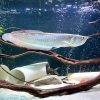Address
Γεωργίου Παπανδρέου 17Α Θεσσαλονίκη 54645
Opening hours
Monday - Friday: 9am - 7pm
Saturday: 9am - 2:30pm
Address
Γεωργίου Παπανδρέου 17Α Θεσσαλονίκη 54645
Opening hours
Monday - Friday: 9am - 7pm
Saturday: 9am - 2:30pm






110.00€
Available on backorder
Ischnosoma bicirrhosum Cuvier, 1829; Osteoglossum vandellii Cuvier, 1829; Osteoglossum bicirrhosum Spix & Agassiz, 1829; Osteoglossum arowana Jardine, 1841; osteoglossum minus Valenciennes, 1847
Osteoglossum: from the Greek osteon, meaning 'bone', and glossa, meaning 'tongue'.
bicirrhosum: from the Latin bi, meaning 'two', and cirrhosum, meaning 'tendrilled', in reference to this species' barbels.
Cuvier gave type locality as 'Brazil', with modern records indicating it to range throughout much of the Amazon basin in Brazil, Peru, Colombia and Ecuador, plus the Rupununi and Oyapock systems in Guyana and French Guiana, respectively.
In the rio Negro, Brazil, plus a handful of blackwater rivers draining into the Río Orinoco through eastern Colombia it's replaced by the congener O. ferreirai while there exist no records of the genus from the Orinoco or other drainages in Venezuela.
Tends to inhabit slow-moving to still tributaries, backwaters and lagoons during the dry season, and moves into areas of flooded forest during periods of inundation.
It's chiefly a surface dweller preying on smaller fishes and terrestrial insects, and is famed for its ability to leap high out of the water to catch the latter.
700 - 800 mm.
Suitable only for public installations or the very largest private aquaria.
Relatively unfussy although some surface cover in the form of floating or overhanging vegetation or branches is appreciated.
It does best if there is a high proportion of dissolved oxygen and moderate degree of water movement so external filters, powerheads, airstones, etc., should be employed as necessary.
As stable water conditions are obligatory for its well-being this fish should never be added to biologically-immature aquaria and weekly water changes of 30-50% aquarium volume should be considered mandatory.
A tight-fitting, heavy cover is also essential as Osteoglossum spp. are prodigious jumpers.
Temperature: 20 - 30 °C
pH: 5.0 - 7.5
Hardness: 36 - 268 ppm
This species is a generalised predator with intestinal analyses of wild specimens revealing the natural diet to consist of other fishes, terrestrial insects, aquatic invertebrates and plant material in the form of fallen nuts and fruits.
Smaller specimens can be offered bloodworm, small earthworms, chopped prawn and suchlike while adults will accept strips of fish flesh, whole prawns/shrimp, mussels, live river shrimp, larger earthworms, etc.
Insects such as crickets or are also suitable to use although it's best to fill the stomachs of these by feeding them fish flakes or some kind of vegetable matter before offering them to the fish, while floating dried products can also be used in limited quantities.
Like the vast majority of predatory fishes this species should not be fed mammalian or avian meat such as beef heart or chicken.
Some of the lipids contained in these cannot be properly metabolised by the fish and can cause excess fat deposits and even organ degeneration.
Similarly there is no benefit in the use of 'feeder' fish such as livebearers or small goldfish which carry with them the risk of parasite or disease introduction and at any rate tend not to have a high nutritional value unless properly conditioned beforehand.
Peaceful with anything too large to swallow and can be maintained in a community provided tankmates are chosen with care.
Aggressively territorial or very competitive species should be avoided with the best choices being similarly-sized fishes such as Cichla spp. and larger doradid or loricariid catfishes.
Other surface-dwellers are best avoided in anything but the very largest installations.
This species can be aggressive towards conspecifics if space is limited and even in larger set-ups a group will form a distinct pecking order.
| Weight | 4 kg |
|---|---|
| Manufacturer | Singapore |